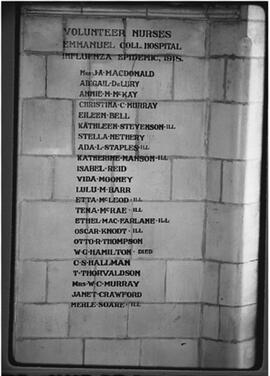Household Science - Group Photo
- A-6366
- Item
- 1917
Ethel B. Rutter, instructor in Household Science, standing at far left at a lab station with ten students in the Household Science lab, located in the northwest corner of the College Building. Kitchen equipment in foreground; blackboard, clock and a set of doors in background. Students (l to r): Lula Mabel Barr, Bessie Mary Lakken, Lillian Ivanella Crum, Mary Elizabeth Jeanetta (Jean) Moore, Ethel Falkner, Rhea Walker, Mable Jane Pollock, Beulah Ferne Bannerman Bridgeman, Hilda Gruchy, Mildred Smith.
Bio/Historical Note: In 1906, Ethel Brittain Rutter (1876-1964), PhB, MA, was widowed with two small children. Rutter received the Gold Medal for proficiency in Household Science from Macdonald College, McGill University, in 1908. She went on to serve on the faculty of Macdonald College. In 1916, Rutter joined the University of Saskatchewan to teach Household Science. Taking summers to study and a year’s leave, she earned the Bachelor of Philosophy degree from the University of Chicago and the Master of Arts degree from Columbia University. In 1928, the School of Household Science was established within the College of Arts and Science. Rutter was instrumental in setting up the degree program, and in 1929 was named Head of the School. She taught classes in food and nutrition, family relations and methods of teaching. To quote from the Canadian Home Economics Journal of March 1955: “Students in Mrs. Rutter’s classes recalled her insistence on accuracy, her high standards of workmanship, her apt phrasing and, above all, her enthusiasm for her subject.” Outside of the University, she encouraged the study of home economics in women’s organizations and constantly stressed the need for employing trained dietitians in hospitals. Upon her retirement in 1940, Professor Rutter was named Professor Emerita of the University of Saskatchewan. She was a Charter Member of the Canadian Dietetics Association (now Dietitians of Canada), Honorary Member of the Canadian Home Economics Association and Honorary Life Member of the McGill Graduate Society. The Rutter Prize was established in 1930 to recognize the most distinguished student in the graduating class of the College of Home Economics. The Rutter Medal now honours the most distinguished Bachelor of Science in Nutrition graduate. Rutter died in 1964; 'Rutter Crescent' in Greystone Heights is named in her honour.


